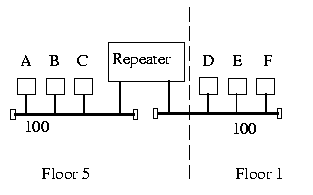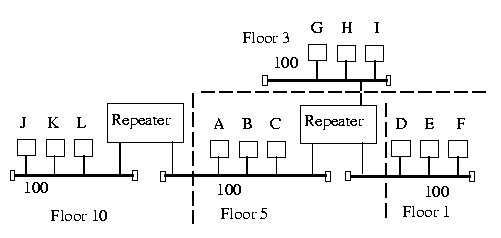| Introduction to Data Communications | ||
|---|---|---|
|
|
39d. Repeater Addressing: MAC Layer and Network Segment | Next |

Nodes A & B could be furiously exchanging files and this network traffic would also appear on Floor 1. Repeaters provide no isolation between segments, there is only one collision domain.
Because Repeaters provide no isolation between segments and the repeater is transparent to both sides of the segment, both sides of the repeater appear as 1 long segment. The Network Number or Segment Number is the same on both sides of the Repeater.
When using repeaters, make sure that the overall propagation delay does not exceed the Physical Layer Standard being used. Repeaters will add a propagation delay to the signal that is being repeated also. Check that rules such as the 5-4-3 Rule for IEEE 802.3 are not broken or for XNS Ethernet that a maximum of only 2 Repeaters are between any 2 nodes.
You are allowed to parallel Segments using multiport repeaters. Multiport repeaters have several inputs/outputs. Notice that all floors have the same Segment Number. You are not allowed to create a loop between two segments by using two repeaters.

Fibre Optic Repeaters join 2 segments together with a fibre optic link. The Transfer rate is not changed through the fibre. The advantage is noise immunity and longer distances. Segments can be joined up to 3000m apart and still be within the propagation delay specification for the Physical Layer. Two fibre optic repeaters are required: one at each end of the fibre.

| Introduction to Data Communications | ||
|---|---|---|
|
|
Table of Contents | Next |